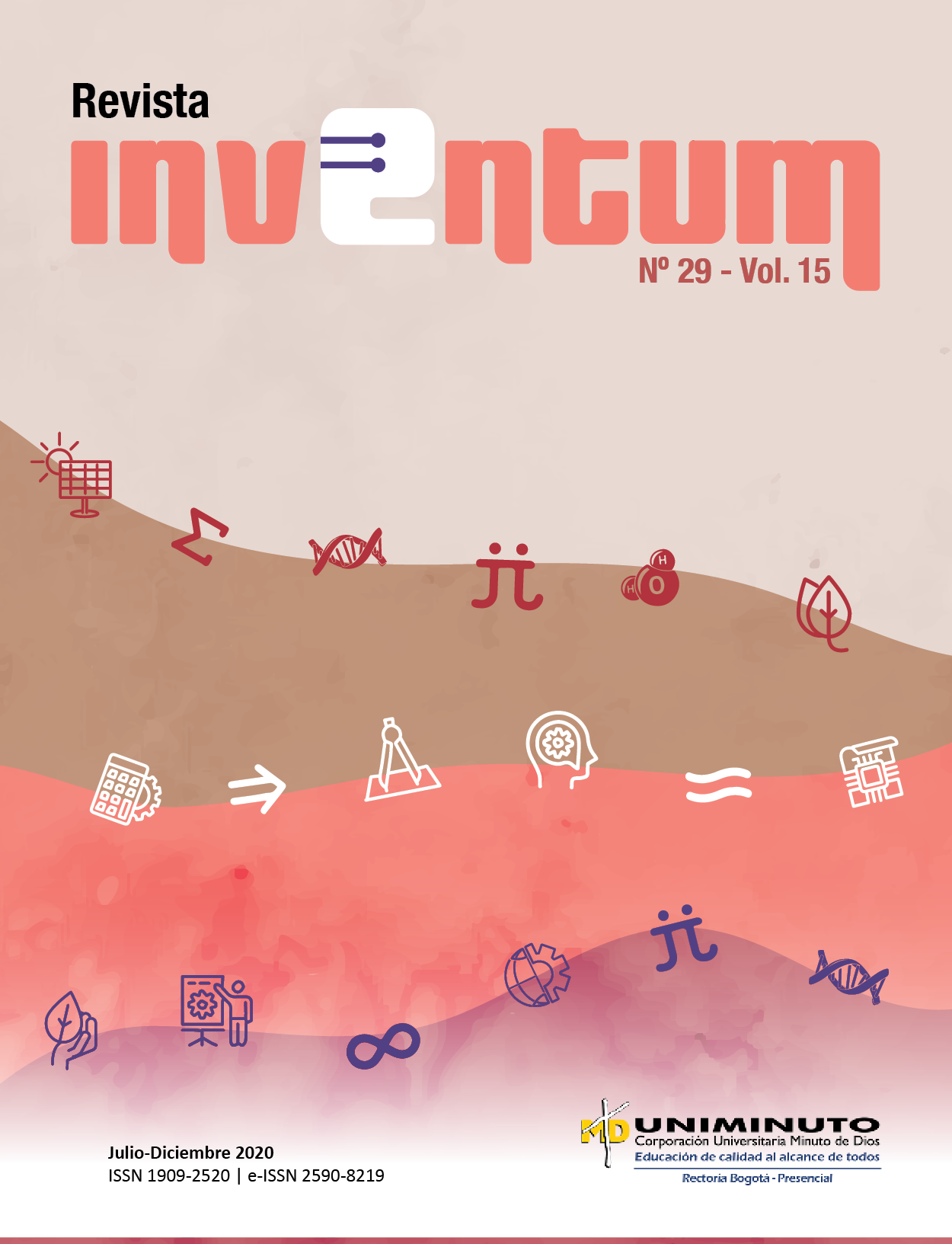Análisis del flujo de pacientes utilizando la simulación discreta en una unidad de quimioterapia de una organización sin ánimo de lucro
Barra lateral del artículo
Cómo citar
Altmetrics
Detalles del artículo
Se solicita a los autores que diligencien el documento de cesión de derechos de autor sobre el artículo, para que sea posible su edición, publicación y distribución en cualquier medio y modalidad: medios electrónicos, CD ROM, impresos o cualquier otra forma, con fines exclusivamente científicos, educativos y culturales
- La obra pertenece a UNIMINUTO.
- Dada la naturaleza de UNIMINUTO como Institución de Educación Superior, con un modelo universitario innovador para ofrecer Educación de alta calidad, de fácil acceso, integral y flexible; para formar profesionales altamente competentes, éticamente responsables y líderes de procesos de transformación social, EL CEDENTE ha decidido ceder los derechos patrimoniales de su OBRA, que adelante se detalla para que sea explotado por ésta
- El querer de EL CEDENTE es ceder a título gratuito los derechos patrimoniales de la OBRA a UNIMINUTO con fines académicos.
Contenido principal del artículo
Resumen
La simulación discreta es una herramienta que permite tener un panorama del sistema y una fácil trazabilidad de las variables de interés. En el presente artículo se realiza una representación de una unidad de quimioterapia con el fin de mejorar la utilización de los recursos disponibles en un modelo de simulación discreta que representa el sistema determinado por sus variables clave como: arribo de pacientes, el tiempo de estadía, personal requerido y las operaciones asociadas. Se propone una metodología de segmentación de pacientes basándose en los tiempos de infusión según protocolos. Posteriormente, se plantean diversos escenarios dentro de dos experimentos conservando la demanda como parámetro fundamental y se modifica el recurso variable con el fin de atender a la mayor cantidad de pacientes posibles. Finalmente, el estudio permitió encontrar una adecuada combinación de recursos (combinación de enfermeras oncólogas y auxiliares de enfermería) para obtener la reducción deseada en el tiempo de estancia.
Referencias
[2] S. M. Thompson, R. Day, and R. Garfinkel, “Improving the flow of patients through healthcare organizations”, en Handbook of healthcare operations management, New York: Springer, 2013, pp. 183–204. doi: https://doi.org/10.1007/978-1-4614-5885-2
[3] M. Chong et al., “Patient flow evaluation with system dynamic model in an emergency department: Data analytics on daily hospital records”, en 2015 IEEE international congress on big data, New York, 2015, pp. 320–323.
doi: https://doi.org/10.1109/BigDataCongress.2015.54.
[4] S. Barnes, B. Golden, and S. Price, “Applications of agent-based modeling and simulation to healthcare operations
management”, en Handbook of healthcare operations management, New York: Springer, 2013, pp. 45–74, doi:https://doi.org/10.1007/978-1-4614-5885-2_3.
[5] T. Bountourelis, M. Y. Ulukus, J. P. Kharoufeh, and S. G. Nabors, “The modeling, analysis, and management of intensive care units”, en Handbook of healthcare operations management, New York: Springer, 2013, pp.
153–182. doi: https://doi.org/10.1007/978-1-4614-5885-2_6.
[6] C. D. Pegden and D. T. Sturrock, Rapid modeling solutions: introduction to simulation and Simio, Sewickley, Pennsylvania Simio Forward Thinking, 2014.
[7] W. D. Kelton, J. S. Smith, D. T. Sturrock, and A. Verbraeck, Simio & simulation: Modeling, analysis, applications, Sewickley, Pennsylvania Learning Solutions Chennai.
[8] K. Bertsch, Day-of-Discharge Planning at Acute Care Hospitals, thesis, Master of Science in Engineering, Wright State
University, Dayton (Ohio) 2014. [Online]. Available: https://corescholar.libraries.wright.edu/etd_all/1235.
[9] Case, and K. Ellis, “Simulation-Based Improvement of the Discharge System in Highly Utilized Hospitals”, en Winter
Simulation Conference, Maryland, 2019, Consultado: jul. 17, 2020. [Online]. Available: https://www.simio.com/resources/papers/WinterSim2019/Simulation-Based-Improvement-of-the-Discharge-System-in-Highly-Utilized-Hospitals.php.
[10] M. Khasawneh, “Reducing Patient Waiting Time in an Outpatient Clinic: A Discrete Event Simulation (DES) Based Approach”, Pittsburgh, Pennsylvania 2017, [Online]. Available: https://www.researchgate.net/profile/Niamat_Ullah_Ibne_Hossain/publication/317730692_Reducing_Patient_Wai
ting_Time_in_an_Outpatient_Clinic_A_Discrete_Event_Simulation_DES_Based_Approach/links/5975a806a6fdcc83488e
9320/Reducing-Patient<-Waiting-Time-inan-Outpatient-Clinic-A-Discrete-Event-Simulation-DES-Based-Approach.pdf
[11] S. Suss, N. Bhuiyan, K. Demirli, and G. Batist, “Toward Implementing Patient Flow in a Cancer Treatment Center to Reduce Patient Waiting Time and Improve Efficiency”, JOP, vol. 13, n.° 6, pp. e530-e537, may 2017, doi:10.1200/JOP.2016.020008.
[12] C. Forero-Almanza, M. A. Martínez, y M. Mauricio Herrera, “Modelo de simulación relacionado con la
https://www.simio.com/resources/papers/WinterSim2016/Eradicating-the-Average-Answering-Complex-Healthcare-Questions-Using-Discrete-Event-Simulation.php.
[14] C. M. DeRienzo, R. J. Shaw, P. Meanor, E. Lada, J. Ferranti, and D. Tanaka, “A discrete event simulation tool to support and predict hospital and clinic staffing”, Health Informatics J, vol. 23, n.° 2, pp. 124-133, jun. 2017, doi: 10.1177/1460458216628314.
[15] Bernatchou, Maryam, Adil Bellabdaoui, and Fatima Ouzayd. 2017. “Performance Evaluation of a Chemotherapy Treatment Unit through Simulation.” In Proceedings of the International Conference on Industrial Engineering and Operations Management, Rabat, Moroco, 2017, pp. 5720–5726. [Online] Available: http://ieomsociety.org/ieom2017/papers/582.pdf
[16] T. M. Abuhay, A. V. Krikunov, E. V. Bolgova, L. G. Ratova, and S. V. Kovalchuk, “Simulation of Patient Flow and Load of Departments in a Specialized Medical Center”, Procedia Computer Science, vol. 101, pp. 143-151,
ene. 2016, doi: 10.1016/j.procs.2016.11.018
[17] L. M. Pantoja Rojas, y L. A. Garavito Herrera, “Análisis del proceso de urgencias y hospitalización del CAMI Diana Turbay a través de un modelo de simulación con Arena 10.0 para la distribución óptima del recurso
humano”, Ingeniería e Investigación, vol. 28, n.° 1, pp. 146-153, abr. 2008. [En línea]. Disponible en: http://www.scielo.org.co/scielo.php?script=sci_arttext&pid=S0120-5 6 0 9 2 0 0 8 0 0 0 1 0 0 0 1 6 & l n g = e n &nrm=iso
[18] M. Alvarado, T. G Cotton, N. Lewis, E. Perez, y W. Carpentier, “Modeling and simulation of oncology clinic operations in discrete event system specification”, vol. 94, n°. 2, pp. 105-121, may 31, 2017. [En línea]. Disponible
en: https://journals.sagepub.com/doi/full/10.1177/0037549717708246, doi: https://doi.org/10.1177/0037549717708246
[19] G. Lamé, O. Jouini, and J. S.-L. Cardinal, “Combining Soft Systems Methodology, ethnographic observation, and discreteevent simulation: A case study in cancer care”, Journal of the Operational Research Society, pp. 1-18, jun. 2019, doi: 10.1080/01605682.2019.1610339.





